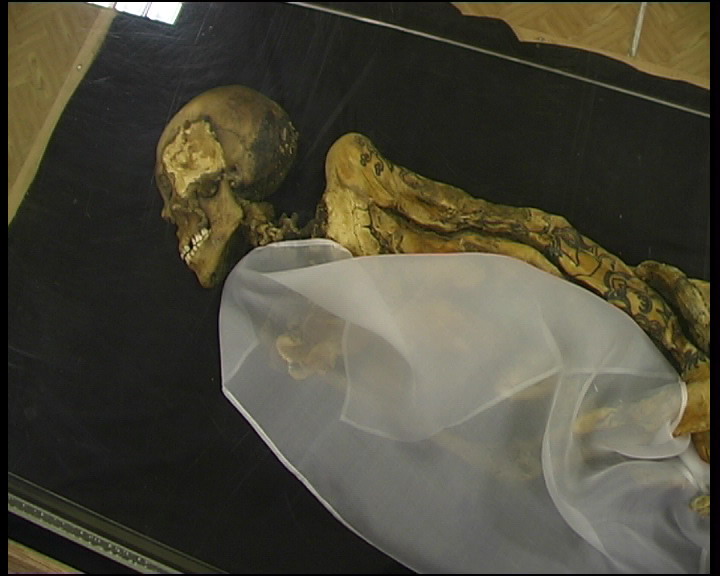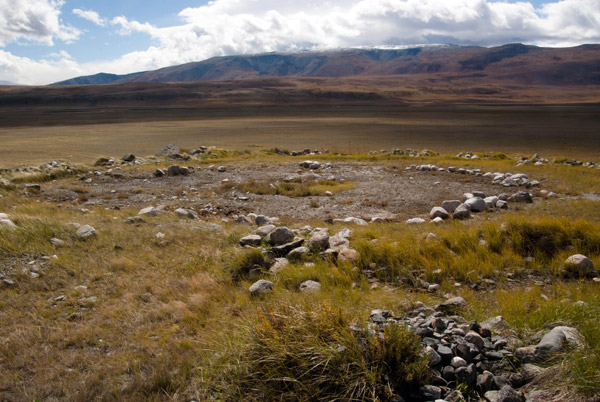Journey Back in Time: The Ukok Princess Emerges from Ancient Siberia
In the annals of history, few discoveries captivate the imagination like the enigmatic Ukok Princess. A remarkable mummy from Siberia, she offers a fascinating glimpse into a bygone era, captivating the world with her compelling story. Residing in Siberia around five centuries BCE, this distinguished woman, often referred to as the “Siberian Ice Maiden,” was unveiled in 1993, shrouded in mystery and adorned with ornate tattoos. Her burial site was graced by the presence of an unexpected companion – a satchel of weed, sparking intrigue about her life and purpose.
A Tapestry of Tattoos: The Artistry of the Ukok Princess

The Ukok Princess wears her history on her skin, adorned with a symphony of tattoos that tell a tale of mythology and status. Mythical creatures and animals dance across her body, from a deer-like creature with goat horns to an argali, a mountain sheep, with a bird’s beak. A snow leopard with wings adds an air of mystique, hinting at battles between predators and herbivores. These intricate tattoos signify more than just artistry; they offer insights into the Pazyryk culture’s values. Dr. Natalia Polosmak, the scientist who discovered the mummy, explains that these tattoos served as forms of identification, connecting people across life and death.
A Tragic Tale: Insights into the Princess’s Untimely Demise
Advanced technology allowed us to unlock the secrets of the Ukok Princess’s fate. MRI scans conducted in 2010 revealed a tragic narrative – she likely succumbed to breast cancer during her mid-twenties. Her skeletal remains bore witness to her battle, with the cancer having reached an advanced stage. Surprisingly, her skeleton showed no signs of physical trauma, dispelling theories of a violent end. This revelation raises questions about the role of the mysterious substance found in her possession.
Unraveling the Weed’s Purpose: Was the Ukok Princess a Shaman?

Beside the Ukok Princess lay a satchel containing an ancient relic – marijuana. Scholars speculate that this plant may have served medicinal or shamanistic purposes, potentially providing relief from the princess’s pain. Her elaborate burial hints at a high status, further supported by the presence of six magnificently adorned horses. This ensemble prompts us to consider an intriguing possibility – was the Ukok Princess a shaman, entrusted with healing rituals and ceremonies?
Noble Companions: Horses and Artistry in the Afterlife
The Ukok Princess embarked on her afterlife journey accompanied by six horses, each outfitted with intricate harnesses and vibrant felt saddles. These loyal steeds symbolized not only her status but also the spiritual significance of her passage to the beyond. Her exquisite burial attire, including jewelry and a silk gown, reaffirms her royal or elevated social standing. Notably, the presence of Chinese silk underscores her exceptional importance within the Pazyryk culture.
Resurrecting the Past: The Ukok Princess Reimagined
In 2014, a taxidermist breathed life into the Ukok Princess’s visage, recreating her appearance with meticulous detail. Marcel Nyffenegger’s artistry allowed the princess to transcend time, bringing forth her likeness from millennia ago. A labor of love, Nyffenegger’s reconstruction employed advanced techniques, from 3D modeling to the careful assembly of a horsehair wig. This lifelike representation stands as a testament to the enduring allure of the Ukok Princess.
The Unsettling Legacy: Disasters and Disagreements

The Ukok Princess’s relocation from her resting place stirred unsettling consequences reminiscent of ancient curses. Natural disasters plagued the Altai Republic, triggering speculation about the spiritual repercussions of disturbing sacred land. The dispute over her remains escalated between the Altai Republic and larger authorities, highlighting the profound cultural significance of this ancient figure. Eventually, the princess was returned to a museum in the Altai Republic, but not to her original burial site.
Preserving the Past: An Ethical Imperative

The people of the Altai Republic resolved to honor their ancestors and the Ukok Princess by declaring her resting place a “zone of peace.” In a world often driven by excavation and progress, this decision underscores a commitment to respect and cultural preservation. Plans for a gas pipeline through the Ukok area were suspended, reflecting a collective determination to safeguard the past for generations to come.
An Echo from Ancient Times: The Pazyryk Legacy
The Ukok Princess emerges as a poignant representation of the Pazyryk culture, a vibrant society that thrived during Siberia’s Iron Age. The Pazyryks left a legacy woven with tattooed myths, ornate bridles, and tables sculpted in the likeness of lions. Nomads who revered horses, they sculpted their afterlife with intricate textiles and artistic finesse. The Ukok Princess, a luminous jewel from their midst, offers a timeless glimpse into their world.
The Ukok Princess, also known as the “Siberian Ice Maiden,” was a woman of high status who lived in Siberia around five centuries BCE. Her remarkable mummified remains were adorned with ornate tattoos and found alongside a satchel of weed.
The intricate tattoos on the Ukok Princess depict mythical creatures and animals, reflecting the values and status of the Pazyryk culture. These tattoos served as forms of identification and were believed to aid in the afterlife.
MRI scans conducted in 2010 suggest that the Ukok Princess likely died from breast cancer in her mid-twenties. Despite her advanced cancer, her skeletal remains showed no signs of physical trauma.
Scholars speculate that the Ukok Princess may have used marijuana for medicinal or shamanistic purposes, possibly to alleviate her pain. Her burial and the presence of horses suggest she held a significant role in her community.
The Ukok Princess’s relocation stirred natural disasters and disagreements between the Altai Republic and larger authorities. The Altai people believed that disrupting sacred land caused calamities



